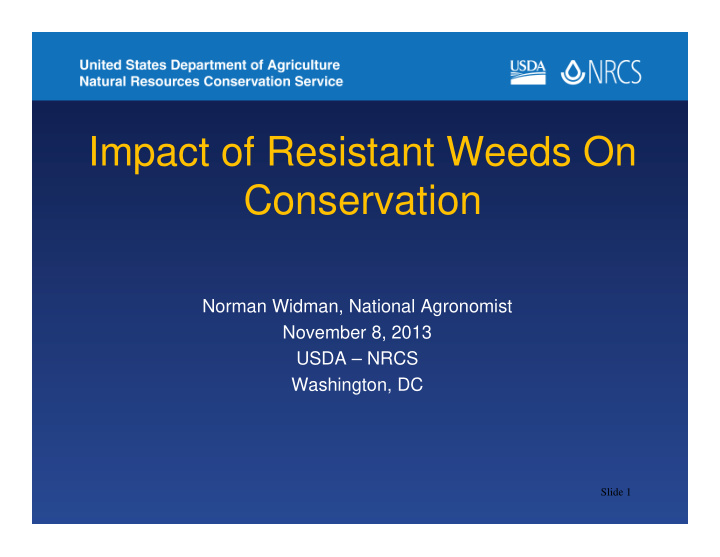



Impact of Resistant Weeds On Conservation Norman Widman, National Agronomist November 8, 2013 USDA – NRCS Washington, DC Slide 1
Impact of Herbicide Resistance on Natural Resources Judicious • Soil use of • Water herbicides • Air support • Plant natural • Animals resource • Energy Conservation conservation Slide 2
Herbicide Resistance Impact on Crop Production Reduced income Fewer herbicide options Fewer crop options ???? More expensive herbicide options Slide 3
Potential Behavior Changes with Herbicide Resistance More Intensive Tillage Use Alternative Pesticides Reduce or Abandon Economic Crops Opportunity to Improve*** Slide 4
Herbicide Resistance Impacts The negative impact to crop production and economics The negative impact to conservation efforts Slide 5
If we use more intensive tillage to address herbicide resistant weeds… Slide 6
Weed Resistance - Negative Impacts to Conservation Efforts Wind Erosion Water Erosion Water Quality Air Quality Wildlife Plant Communities Slide 7
Herbicide Resistance Impact on Conservation Herbicides facilitate conservation tillage Conservation tillage is dependent upon herbicides for weed control Photos courtesy of: University of Minnesota (2) and USDA (2) Slide 8
Griggs Washington Benton Butler Bucks Burlington 8 Locations Tulsa Grant Madison Macon Locations Evaluated for Soil Loss Comparisons Slide 9
Effect of Tillage on Water Erosion Erosion by Tillage Type and Location Corn and Soybean Rotation Primary Change 30 will be less No Till 26 24 25 23 23 20 Erosion Rate NT C and SB 15 Tons/Ac/Yr 13 MT C and SB Plow C and SB 10 8.5 8.4 7.7 7.7 5.3 5 4.7 5 2.8 1.7 1.4 1.2 0.79 0.5 0 ND NE TN GA IA PA Locations Slide 10
Effect of Tillage on Water Erosion Erosion by Tillage and Location Corn and Cotton Rotation 40 36 35 30 25 22 Erosion NT C and Ctn 20 18 Tons/Ac/Yr MT C and Ctn 15 Plow C and CTN 11 10 5 2.9 1.6 0 OK TN Locations Slide 11
Slide 12 2.7 2.1 4.0 3.3
Water Erosion - 54% occurred in just 2 of the 10 farm production regions—the Corn Belt and the Northern Plains Wind Erosion - 93% occurred in 4 of the 10 farm production regions—the Northern Plains, Southern Plains, Mountain, and Lake Slide 13 States
Slide 14
Conservation Effect of Water Erosion Per 2007 NRI we have 304.9 M acres of cultivated cropland in the US. For each 1 • 1.4 B Tons N/Yr. ton/ac/yr. increase • 228 M Tons P/Yr. in water erosion • 365 B Ton Sediment/Yr. this equals: • 24 B Tons Carbon/Yr. Slide 15
We Cannot Go Backwards on Conservation Water Erosion/Water Wind Erosion/Air and Quality/Productivity Water Quality/Productivity Slide 16
Opportunity to Improve • What got us into this problem? – Tillage choices – can change – Crop choices – can change – Rotation choices – can change – Herbicide choices – can change – Weed adaptability – we can influence If we keep doing things the same way – things will not get better Slide 17
Future Technical Solutions to Address Herbicide Resistance must be: • Environmentally sound • Economically sound • Socially acceptable This must be reflected at the farm level, local, state, and national levels. Slide 18
Changes involve more than just… Changing herbicide mode of action Rotation Tillage Slide 19
Change will require… Understanding the science/biology of the problem Behavior change by producers, industry, and government Farmers, industry, and government working together at all levels Environmentally sound, Economically sound, Socially acceptable Slide 20
Understanding the science/biology of the problem • Cultural/Biological methods (rotations, types of crops, Needed to timings, tillage or lack of tillage) • Chemical methods (pesticides, develop… modes of action, timing, etc.) • Behavior Change Slide 21
Behavior change by producers, industry, and government • Production practices Willingness • Marketing strategies to • Government Policy change… to facilitate change Slide 22
Farmers, industry, and government working together at all levels Information • Local level and Education • State/Regional Level at the… • National Level Everyone must be on the same page Slide 23
Some Examples of Good Things Happening NRCS and other Conservation Org’s – Technical and Financial Assistance Land Grant Universities – Research and Education ARS and ERS – Research Industry – Commodity Org’s and Farmers Slide 24
NRCS Technical Assistance to Facilitate Information and Education Partner with industry, commodity groups, extension, crop consultants, etc. • National Level • State Level • Local Level Slide 25
We need more…. • New technology Need more • Better Understanding the biology and information and science of the problem education for • More long and short-term economic producers scenarios to change behavior. Need a “consistent message” from industry and government Slide 26
Summary There are negative conservation implications of using more tillage to address herbicide/pesticide resistance. Environmental, Economic, and Social solutions are possible and will present an opportunity to improve. A coordinated effort at levels by producers, industry, and government is needed. Slide 27
Recommend
More recommend